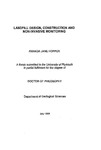Landfill design, construction and non-invasive monitoring
| dc.contributor.author | Hopper, Amanda Jane | |
| dc.contributor.other | School of Geography, Earth and Environmental Sciences | en_US |
| dc.date.accessioned | 2011-09-23T10:49:34Z | |
| dc.date.accessioned | 2013-10-03T10:11:45Z | |
| dc.date.available | 2011-09-23T10:49:34Z | |
| dc.date.available | 2013-10-03T10:11:45Z | |
| dc.date.issued | 1998 | |
| dc.identifier | Not available | en_US |
| dc.identifier.uri | http://hdl.handle.net/10026.1/626 | |
| dc.description | Access to the full-text thesis is no longer available at the author's request, due to 3rd party copyright restrictions. Access removed on 28.11.2016 by CS (TIS). | |
| dc.description | Metadata merged with duplicate record (http://hdl.handle.net/10026.1/1989) on 20.12.2016 by CS (TIS). | |
| dc.description.abstract |
Three techniques are investigated in order to assess their applicability for use in landfill design, construction and monitoring. Firstly, an assessment is made of QA procedures during liner construction through the detailed evaluation of two case studies. Construction QA procedures on-site are compared to available guidelines. The research illustrates the requirement for standardised, regulated QA procedures on landfill sites in order to provide a recognised framework for construction control. The Moisture Condition Value Test (MCV) is evaluated for use as a method of monitoring the placement of compacted clay landfill liners. London Clay and Mercia Mudstone, collected from the QA case study sites, are tested in terms of their suitability as engineered clay liners. Although, London Clay is the most acceptable it is this material which exhibits the poorest results in the MCV testing. This is due to seepage from the apparatus at high moisture contents. The research highlights the problems with the interpretation of the protocol for the testing and the differences between the Scottish and English Road Research Laboratory guidelines (Green & Hawkins, 1987). Thirdly, two airborne remote sensing techniques (ATM and CASI) are appraised as methods of monitoring landfill gas, or possibly leachate migration, from two case study landfill sites in South West England. Vegetation stress can be linked to landfill gas migration (Flower et al., 1981) and this stress can be detected as a deviation from normal spectral reflectances in vegetation (Honer et a!., 1983a). Anomalies are identified on-site through remote sensing but they cannot be directly attributed to the landfills. This research emphasises the effects of contamination from other sources. It also requires the use of a simultaneous ground survey to collate data from boreholes with measurements of soil and vegetation types. Essentially, the QA case studies and the remote sensing show potential for future use and suggestions are made in this thesis for further research. The MCV technique provides a method for assessing the controlling parameters of compaction. With further development of aspects outlined in this investigation there is the potential for specified use of these techniques In landfill engineering and monitoring. | en_US |
| dc.language.iso | en | en_US |
| dc.publisher | University of Plymouth | en_US |
| dc.title | Landfill design, construction and non-invasive monitoring | en_US |
| dc.type | Thesis | |
| plymouth.version | Full version | |
| dc.identifier.doi | http://dx.doi.org/10.24382/3498 | |
| dc.identifier.doi | http://dx.doi.org/10.24382/3498 |
Files in this item
This item appears in the following Collection(s)
-
01 Research Theses Main Collection
Research Theses Main



